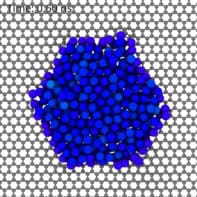
Workers building the colossal monuments of ancient Egypt may have added water to the desert sands to make it easier to haul giant sledges. That is the conclusion of an international team of physicists that studied the relationship between friction and water content in a number of different types of sand. The research suggests that the type of sand found in the Egyptian desert becomes particularly slippery when wet – something that might have made it much easier to move the huge stones that were used to build the pyramids.
The study was done by Christian Wagner and colleagues at Saarland University in Germany, along with researchers in the Netherlands, Iran and France. The team was inspired by an ancient Egyptian wall painting showing a huge statue being hauled across the sand on a sledge in about 1800 BC. The painting has a detail that has long puzzled Egyptologists: a worker who appears to be pouring water onto the sand in front of the sledge while others appear to be carrying water to replenish his supply.
Ritual or lubrication?
While some historians believe that the act of pouring a liquid could be some sort of ritual, Wagner and colleagues wondered if it was a practical measure to reduce friction between the sledge and sand. This thought was inspired by work done in 2007 by Wagner, along with his Saarland colleague Jorge Fiscina, who showed that just a small amount of water acts as a lubricant that reduces friction in sand that is being pushed through a tube (see “Wet sand flows better than dry”).
To test their new theory, Wagner, Fiscina and colleagues measured the resistance experienced by a sledge being dragged through different types of sand. The team’s sledge was made from PVC, measured 11 × 7.5 cm and had rounded edges to mimic its ancient counterparts. It was loaded with heavy weights so that it exerted a downward force of about 250 kg/m2, which is on a par with that of a loaded Egyptian sledge. The sledge was pulled by a tensile tester, which measured the force required to move the sledge and allowed the team to calculate the coefficient of dynamic friction. While the researchers found that the addition of water did indeed reduce friction, it was not because the water allowed the sand to flow more freely – indeed, it had the opposite effect.
Concrete-like surface
The team quickly realized that sand piling up in front of the sledge was a major contributor to the friction. When the sand is dry or slightly damp, the grains can move past each other and are easily pushed up into a pile that makes it harder to pull the sledge. As more water is added to the sand, however, the grains begin to stick together and eventually form a stiff concrete-like surface that the sledge can slide across much more easily than across dry sand. This stickiness between grains was also observed in Wagner’s 2007 study, where it impeded the flow of sand.
In the case of one type of sand tested, the coefficient of dynamic friction nearly halved when the water content of the sand reached about 5%. This sand is similar to that found in Egypt, suggesting that wetting the sand would have been a boon to ancient monument builders. The results also indicate that the pyramid builders had luck on their side. Egyptian sand is “polydispersive”, which means that it contains grains of many different sizes. When Wagner and colleagues used sand in which most grains were of a certain size, the drop in friction was much less than that seen in the Egyptian-like sand. This could be because the range of grain sizes in polydispersive sand allows it to pack more tightly than sand where most grains are the same size.
More water does not help
Another important finding by the team is that above 5% water content, friction increased as more water was added. In some cases, friction on sand with 10% water content actually surpassed the value measured for dry sand. Wagner told physicsworld.com that the reason for this increase was not clear because the researchers did not see heaps of wet sand piling up in front of the sledge. Instead, he speculates that wetter sand is softer than the concrete-like sand and so the sledge sinks into it. “Maybe it is a bit like the difference between sliding on concrete and sliding on rubber,” says Wagner. “In any case, this is something we have to investigate in future studies.”
Troy Shinbrot of Rutgers University described the results of the experiment as “compelling” but points out that more work needs to be done to understand the connections between friction and the stiffness of the sand. As for practical applications beyond building pyramids, Shinbrot points out that the research could help us to understand the effects of moisture on processing a range of granular materials from pharmaceuticals to industrial slurries.
The experiments are described in Physical Review Letters.



